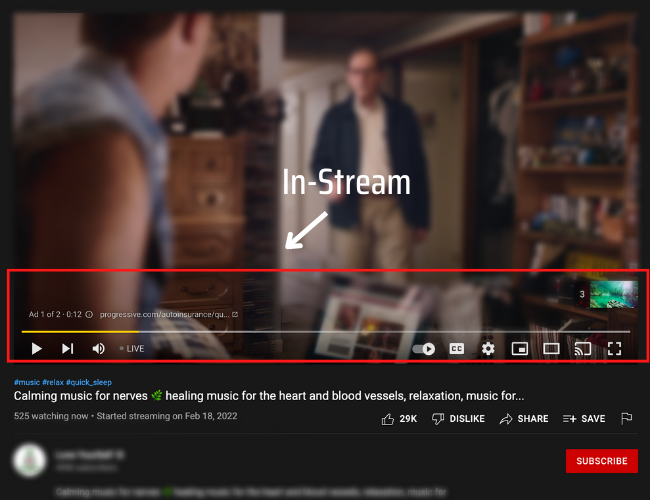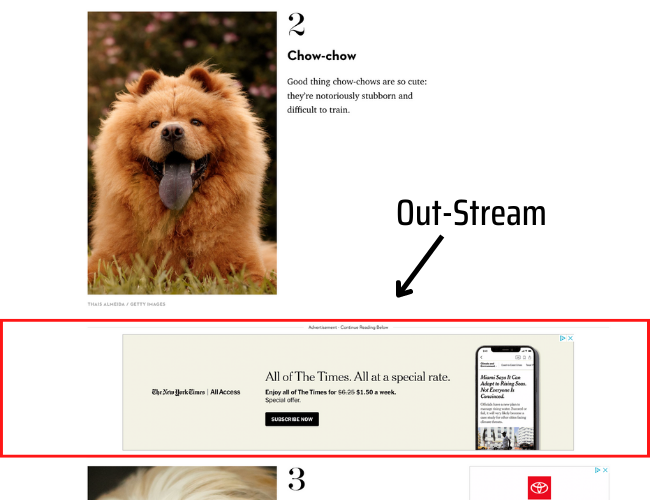A Quick Guide to Programmatic Video Advertising
“When it comes to programmatic video, it makes sense to consolidate video advertising efforts into strategies using DSPs and SSPs. If you aren’t doing this, you are deploying your video inefficiently. Here's a metaphor - Why would you drive all around town for everything you need, when you can swing into a wholesale club retailer? You benefit from the premium quality, discounted prices at bulk quantities. In the same respect, it's in the interest of convenience for a brand, to do more with less effort and achieve a better ROI."
-Sophia Angelosante, Partner Manager, Pathlabs
What is programmatic video advertising? Here's everything you need to know about video programmatic advertising - from the benefits to best practices, and more.
What is Programmatic Video?
If you read our recent blog on programmatic audio advertising, you already understand the benefits of utilizing programmatic advertising methods to attract new customers.
Now, let’s switch our focus from our auditory senses to our visual senses. Today, we will review programmatic video and how, similar to programmatic audio, it is an attractive way to reliably field ads to reach specific target audiences.
What is Programmatic Video Advertising?
Programmatic video advertising is automated selling and insertion of ads into video content such as online video and streaming video services. Programmatic video gives advertisers access to better targeting, measurement, and retargeting to execute campaigns with great efficiency.
Programmatic video allows marketers to insert ads into spaces that are likely to reach potential customers. In the case of video, there are a plethora of places to insert ads. This includes banner ads, preview ads, social media reels, or CTV placements.
Programmatic video advertising eliminates the traditional method of video ad management. In the past, if marketers wanted to field a video ad on a website, they would have to contact the ad space owner directly and negotiate with them to get the ad placed. This takes a lot of work and, under this format, advertisers didn’t have much control over who was going to see their ad.
With programmatic video advertising, we can forget this antiquated advertising system. First off, this new form of advertising eliminates communication with ad space vendors. Instead, this step is automated by using a media planning tool or Demand-Side Platforms (DSP). Media planning tools and DSPs let marketers plug in their ad content and budget, then programmatically navigate the ad exchange environment to buy the ad space.
Additionally, the software uses AI and machine learning to review the target audience’s historic online behaviors to find the best possible placement for ads. It decides how much of a budget should be allocated to different platforms. The best part? These AI decisions take less than a second to be made.
Using this ad format, advertisers are no longer throwing the dart blindfolded - hoping to hit the bullseye. Instead, with machine learning, they can strategically throw the dart to hit the bullseye nearly every time.
The Benefits of Programmatic Video Advertising
“If you are strapped on time and resources, programming your video advertising efforts will help you automate the purchase of impressions, and reach your users where they are most receptive. It makes this buying process even more smooth”.
-Sophia Angelosante, Partner Manager, Pathlabs
Less Time Talking, More Time Executing
As mentioned earlier, by placing video ads programmatically, digital advertisers don’t need to talk to a single person to field their ad. DSPs will navigate the ad exchange market and place ads automatically. If an advertiser doesn’t feel ready to invest in DSPs, media execution partners (MEPs) exist to do the heavy lifting for your team. They manage the media, while your agency can allocate focus elsewhere.
Buckets of Data
Because most programmatic advertising software use AI and machine learning, advertisers will be able to access massive data sets that provide real-time insights into ads.
More Bang for Your Buck
By placing ads programmatically, advertisers can maximize every cent of their budget to reach more target customers.
High Traffic From Your Demographics
Fusing technology with video campaigns allows the user to plug in detailed info about their target demographics for more effective targeting.
Surf Through Different Channels
By spending less time talking to ad exchange vendors, advertisers can develop an omnichannel advertising strategy, and field ads on multiple platforms at once like social media, web, search engines, CTV, etc.
Types of Video Ads
Since we are all daily consumers of media, we see almost all types of video ad methods daily. Let’s quickly run through the formalized names of each ad method that programmatic video campaigns use.
What Are In-Stream Ads?
In-stream ads are video advertisements that are inserted into a certain portion of the video content. Hence, the name. These ads are part of the video stream. In-stream ads are placed at the beginning, middle, or end of video content. In media terms, these are called pre-roll, mid-roll, and post-roll.
Pros
All in-stream ads have a higher chance of being seen because they are the hurdle consumers have to get over to watch their video content. They are also difficult to skip.
Cons
Pre-roll ads can be burdensome to many consumers who are eager to watch the video content they originally clicked on.
Mid-roll ads are commonly placed in the most climatic parts of the video and interrupt content. This can irritate viewers.
Post-roll ads can have low view rates. The average viewer only watches 50-60% of videos, meaning that they will leave before watching your ad at the end.
What Are Out-Stream Ads?
Out-stream ads are not directly part of streamed video content. These are video ads that are placed in locations like web articles or pages. These are most commonly inserted between clumps of text to catch readers' attention while scrolling.
Pros
Out-stream ads are a good way to grab a reader’s attention because they are already focused on the article content, making them naturally read the ad as well.
Cons
Out-stream ads can be very discreet and effective, however, websites can go overboard with the amount of out-stream ads they include, making it very distracting to focus on the actual article content. Your ad may be placed towards the bottom of long articles, this makes it less likely to be seen.
What Are In-Display Ads?
In-display ads show up in search results and are very similar to inorganic ads.
Pros
In-display ads show up at the top of the search results feed. These are a great way to consistently put content in front of potential customers. In-display ads are placed based on user-searched relevant key terms, making them likely to reach your target audience.
Cons
In-display ads are required to display an “AD” graphic. Because of this, many consumers may ignore it by default.
Programmatic Video Best Practices
“In my experience, a best practice in programmatic video advertising is being realistic about getting what you pay for. Most importantly, you need to make sure your KPIs match your advertising methods. Video advertising is helpful for the inherent awareness element of the marketing funnel. If awareness isn’t your main KPI, this might not be for you.”
-Sophia Angelosante, Partner Manager, Pathlabs
To execute a stellar programmatic video campaign, advertisers should focus on both the programmatic ad strategy and the video creatives.
Programmatic Elements
Do your research. Marketers must conduct due diligence on the methods to be used. Agencies typically implement software like The Trade Desk, or outsource to a media execution partner, to fit their needs.
Know the target audience. This doesn’t have to be perfectly nailed down, but the more info provided, the better the AI will perform in reaching your target customers.
Know campaign objectives. What is the goal of your advertising campaign? DSPs or MEPs will better meet these objectives if a framework is laid down. It is important to make personal objectives and track them, to ensure that the programmatic software or MEP is meeting all expectations.
Know your budget. Without a clearly defined budget, you may over or under-spend. You may even reap little rewards.
Creative Elements
Since videos are a chance to truly connect with an audience, they should embody the following elements.
Your logo. This may seem obvious, a video ad should have something visual that customers associate with the agency or business.
Call to action. There is some form of value being offered to customers, a video should be the motivation for the audience to take advantage of it.
Brevity. Video ads should be succinct and to the point. You only get a small window of time to capture your audience’s attention.
Engage customers and reflect on the business. Video ads need to tell a story and show the personality of the business or agency. Gain audience attention by playing around with colors, visual elements, and actors.
Challenges of Programmatic Video
Ad Fraud
Since ads are online, they are not invincible to hackers. Whether they are bots or actual people, they may attack the ads and interfere with the format. They may even attack the AI machine managing the ad budget, making the user spend more than originally planned.
Reporting Could Fall Short
AI and machine learning can generate and track multiple metrics. However, this data can be so complex that those who aren’t very skilled in data analytics may misinterpret it. If the campaign has very specific or unique objectives, the AI may not understand this and fail to report the right metrics.
Lack of Control and Knowledge
With programmatic video, software often takes the reins with fielding ads. This may be a tough transition for teams to take a step back and let the AI do the heavy lifting.
Along with this, at the end of the day, we aren’t all coders or programmers. For marketers, we might not know if our AI is working efficiently. This may result in unavoidable problems like budgeting errors, ads failing to be placed, or ads being placed on inappropriate websites.
Curious about the benefits of working with a media execution partner? Get in touch with Pathlabs to see how we can become an extension of your team.
Contributors: Jacob Treece, Elias Snyders, Sophia Angelosante




